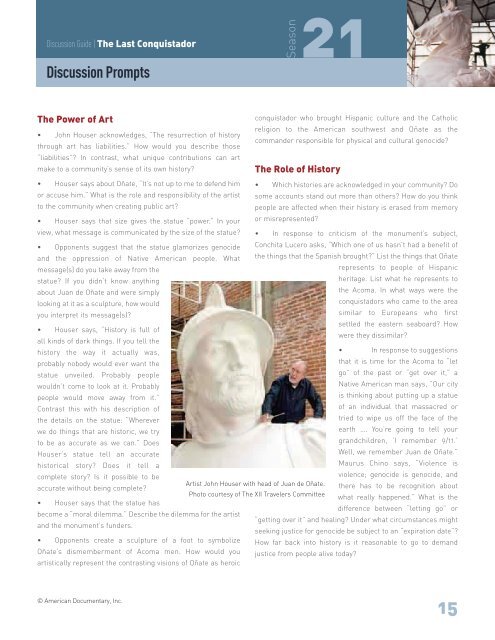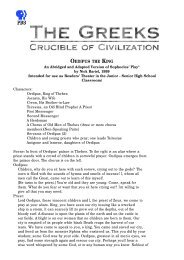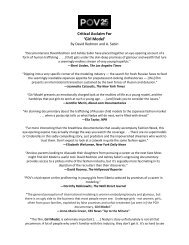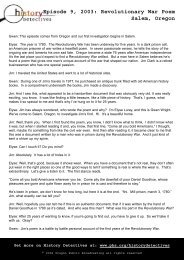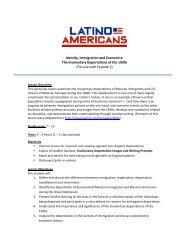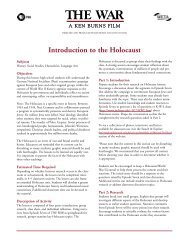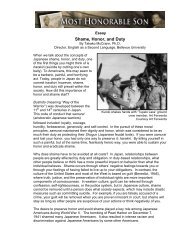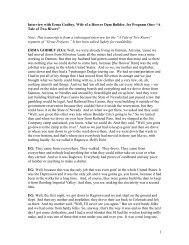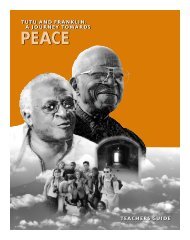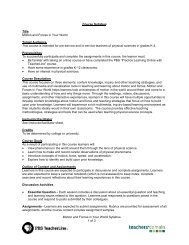DG - The Last Conquistador - PBS
DG - The Last Conquistador - PBS
DG - The Last Conquistador - PBS
You also want an ePaper? Increase the reach of your titles
YUMPU automatically turns print PDFs into web optimized ePapers that Google loves.
Discussion Guide | <strong>The</strong> <strong>Last</strong> <strong>Conquistador</strong>Discussion PromptsSeason21<strong>The</strong> Power of Artconquistador who brought Hispanic culture and the Catholicreligion to the American southwest and Oñate as the• John Houser acknowledges, “<strong>The</strong> resurrection of historycommander responsible for physical and cultural genocide?through art has liabilities.” How would you describe those“liabilities”? In contrast, what unique contributions can artmake to a community’s sense of its own history?<strong>The</strong> Role of History• Houser says about Oñate, “It’s not up to me to defend him • Which histories are acknowledged in your community? Door accuse him.” What is the role and responsibility of the artistto the community when creating public art?some accounts stand out more than others? How do you thinkpeople are affected when their history is erased from memory• Houser says that size gives the statue “power.” In your or misrepresented?view, what message is communicated by the size of the statue? • In response to criticism of the monument’s subject,• Opponents suggest that the statue glamorizes genocide Conchita Lucero asks, “Which one of us hasn’t had a benefit ofand the oppression of Native American people. What the things that the Spanish brought?” List the things that Oñatemessage(s) do you take away from thestatue? If you didn’t know anythingabout Juan de Oñate and were simplylooking at it as a sculpture, how wouldrepresents to people of Hispanicheritage. List what he represents tothe Acoma. In what ways were theconquistadors who came to the areayou interpret its message(s)?similar to Europeans who firstsettled the eastern seaboard? How• Houser says, “History is full ofwere they dissimilar?all kinds of dark things. If you tell thehistory the way it actually was,• In response to suggestionsprobably nobody would ever want thethat it is time for the Acoma to “letstatue unveiled. Probably peoplego” of the past or “get over it,” awouldn’t come to look at it. Probablypeople would move away from it.”Contrast this with his description ofthe details on the statue: “Whereverwe do things that are historic, we tryto be as accurate as we can.” DoesNative American man says, “Our cityis thinking about putting up a statueof an individual that massacred ortried to wipe us off the face of theearth …. You’re going to tell yourgrandchildren, ‘I remember 9/11.’Houser’s statue tell an accurateWell, we remember Juan de Oñate.”historical story? Does it tell aMaurus Chino says, “Violence iscomplete story? Is it possible to beviolence; genocide is genocide, andArtist John Houser with head of Juan de Oñate.accurate without being complete?there has to be recognition aboutPhoto courtesy of <strong>The</strong> XII Travelers Committeewhat really happened.” What is the• Houser says that the statue hasdifference between “letting go” orbecome a “moral dilemma.” Describe the dilemma for the artist“getting over it” and healing? Under what circumstances mightand the monument’s funders.seeking justice for genocide be subject to an “expiration date”?• Opponents create a sculpture of a foot to symbolize How far back into history is it reasonable to go to demandOñate’s dismemberment of Acoma men. How would you justice from people alive today?artistically represent the contrasting visions of Oñate as heroic© American Documentary, Inc.15


